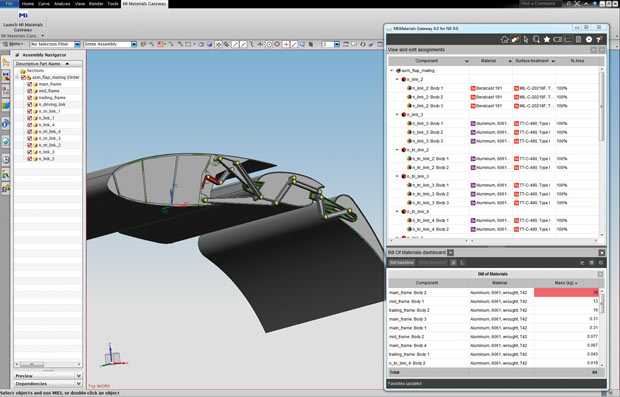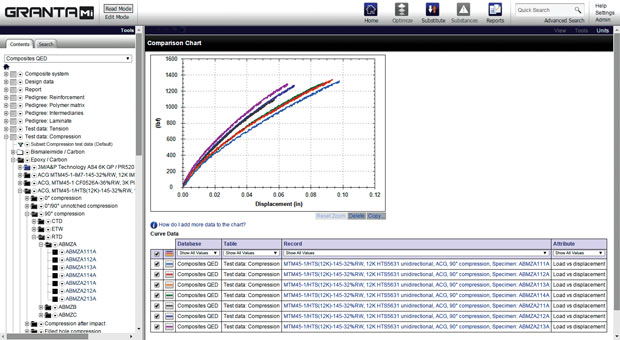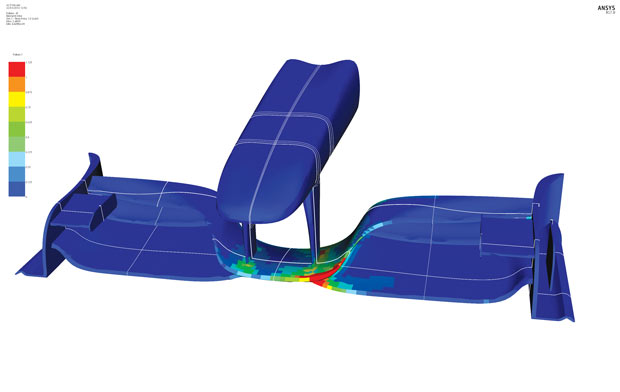
The Granta material database incorporated into the NX CAD program. Image courtesy of Granta Design.
Latest News
July 1, 2016
Kurt Munson, HBM Prenscia’s engineering manager for the nCode product line, once worked at a lab that tests structural components. He uses personal banking as an analogy to explain product durability. “It’s just like a bank account,” he says. “With each incident of damage, you take out a certain amount. If you have big-ticket items that incur a lot of expenditure, the account runs out quickly. Small damages accumulated over time also drain the account. Soon, you go broke.”
 Comparing composites test data in Granta’s Composites QED data module. Image courtesy of Granta Design.
Comparing composites test data in Granta’s Composites QED data module. Image courtesy of Granta Design.To extend the analogy, then fatigue or durability testing must be like ascertaining the account balance. It’s a way to figure out how much damage a product can sustain before it goes broke, in a manner of speaking. “Durability tests are usually done on a candidate part [a design that’s theoretically suitable for production],” says Munson. “You build a prototype and then run physical tests to see if it can survive the expected lifespan, the amount of corrosion, usage cycle and structural loads.”
Testing objects made with composite materials, however, proves far more challenging than metal parts. “The manufacturing process and details of a composite product play a very large part in determining its ability to withstand loads,” Munson says.
Even the decisions made as the composite component is created—fiber strand direction, fiber layup, curing, cooling, molding methods, to name but a few—significantly affect the end product’s strength, durability and flexibility. That makes material characterization and the ability to model the behavior of parts as manufactured a critical part of composite design.
Accelerated Lifecycles
Suppose a typical hood is expected to last five years. It isn’t practical for a manufacturing client to wait five years to get results from a durability test on a new hood design under consideration. A testing service provider must figure out a way to accelerate the hood’s lifespan.
“In such a case, the test lab would accelerate the process, perhaps with a pneumatic machine that continuously executes the same operation—the opening and closing of the hood—for the expected cycles to replicate what happens to the object in its lifetime,” says Munson.The test is relatively straightforward with something as small and disposable as a door handle. You can run tests on dozens of units; you may even deliberately break a few to understand its failure modes. But what if the prototype is on the scale of a Joint Strike Fighter aircraft? “In that case, you may only get one chance to test it,” Munson says.
For replicating a metal product’s lifetime experience, environmental factors may be negligible. But not so with products made with composites. “A humid environment or an arid environment can affect a composite part’s ability to carry load. So the same composite part may behave differently in humid Florida and arid Arizona,” says Munson. The impact of temperature on composites is “another puzzle,” he added.
The use of composites began in aerospace, closely followed by automotive. Both industries consider composites ideal for lightweighting projects, aimed at cutting weight and material from products. More recently, medical equipment makers and other industries began to take an interest in composites. “With devices that need to live in strange environments, like stents inserted into the human body, it may be very difficult to replicate and study some failure modes, such as environmental degradation,” Munson points out.
In addition to software development, HBM Prenscia maintains the Advanced Materials Characterization and Test (AMCT) Facility in Derbyshire, England. Material testing—testing samples in order to characterize the physical behavior of materials’ elasticity, stress-strain response, durability with respect to fatigue or creep, among other things—lays the foundation for digital simulation. Published material data is often incorporated into simulation software programs like those from ANSYS, Siemens PLM Software, Dassault Systèmes or COMSOL.
Digitizing the Act of Production
Engineers working with steel, iron or plastic don’t have to worry about the material-making process. Such standard materials, supplied by established vendors, behave in a fairly uniform manner. But composites are different: They’re designed by combining multiple materials (for example, fiber-reinforced polymer) through weaving and layering. The number of possible configurations—the formulas for how the fiber strands and plies are put together—is virtually infinite. In a sense, the material is created at the same time that the component is manufactured. Therefore, the act of manufacturing itself demands analysis.
Conventional finite element analysis (FEA) packages for structural, heat exchange, airflow and fluid flow studies aren’t designed for this type of micro-scale simulation. Recognizing this need, simulation software vendors began developing or acquiring composite-specific tools, designed to simulate the composite-making process.
 Engineers working with composites may use ANSYS software to analyze and look at failure resulting from multiple criteria in a single plot. This allows engineers to quickly examine every failure mechanism of every layer. Image courtesy of ANSYS.
Engineers working with composites may use ANSYS software to analyze and look at failure resulting from multiple criteria in a single plot. This allows engineers to quickly examine every failure mechanism of every layer. Image courtesy of ANSYS.ANSYS Composite PrepPost is just such a tool. It’s the direct outcome of ANSYS’ 2013 acquisition of EVEN, whose specialty is composite analysis and optimization software. The company writes: “Engineering layered composites involves complex definitions that include numerous layers, materials, thicknesses and orientations. The engineering challenge is to predict how well the finished product will perform under real-world working conditions. Simulation is ideal for this when considering stresses and deformations as well as a range of failure criteria.”
“Composite material behavior is very dependent on how they’re laid up. Three layers of materials arranged at 45° to one another gets you very different results from two layers at 90°. The performance difference is determined all the way down at the fiber and epoxy level,” says Richard Mitchell, lead product marketing manager for Structures at ANSYS.
In aerospace and automotive lightweighting projects, to “optimize” generally means to identify areas where materials can be safely removed without compromising the craft or the vehicle’s safety and structural integrity. But with composites, optimization is far more complex.
ANSYS’ optimization solution is DesignXplorer, integrated with its Workbench product for parametric analysis. “You have to decide what you want to optimize, what you want to see in the results,” says Mitchell. “Do you want to see the amalgamated stress fields? Or look at the stresses layer by layer? Do you want to find the optimal number of layers for a particular region? Or the best angle or shape of the mold? Then you can set some limits in the software, set some goals, leave some things as variables, and ask the software to find the best solution.”
Building Composite Libraries
HBM Prenscia is an exception. Most simulation software makers do not operate their own material testing facilities the way HBM Prenscia does. So companies using simulation must determine the material properties needed for input to simulation codes themselves; or access material data from specialist third party providers. One company that offers help with both options is Granta Design, located in Cambridge, UK.
“For some properties, materials types, or conditions there’s limited ‘off-the-shelf’ data available—composite fatigue might be an example—due to cost and time factors to sufficiently cover the in-service conditions and laminate architectures,” says Stephen Warde, vice president of Granta Design. “Here, the focus is on doing your own testing. Granta helps enterprises to manage and analyze that data so that it can be consumed, for example, in simulation. In other areas, in-house testing is supplemented by great reference resources—examples would be MMPDS (Materials Properties Development and Standardization) for aerospace alloys or the NCAMP (National Center for Advanced Manufacturing Performance) project for continuous fiber composites. These types of datasets most likely cover materials with highly predictable behavior. For example, there is generally greater coverage of short/long fiber composites, and less of continuous fiber composites. Granta’s role is to collect this data from disparate sources and make it available digitally in one place, in a format that is ready for use.”
Granta doesn’t perform material testing; however, it helps organizations manage and use their test data. It also collects and licenses data from trusted partners and public sources into a cohesive library, accessible through its software. Granta’s software is integrated into some leading design software packages. Granta’s MI: Materials Gateway app appears in some simulation software. It’s dubbed “Gateway” because it gives direct access to the Granta material database from within leading simulation software.
Warde emphasizes the factors that make good data management and analysis, complemented with good reference data, are important. “Composites are not coherent ‘bulk materials,’ where a test on a standard sample generates properties that are valid in a wide range of circumstances,” he says. “Continuous fiber composites, for example, are made up of a number of different components and mostly fabricated when manufacturing a part: their properties will be highly dependent on factors such as the exact layup of the components, the exact manufacturing process, and the geometry of the part. Getting useful test data can require a very large number of different tests in order to cover property space for a given composite: and even these will in most cases only provide a guide to the exact performance of a final part.”
Composite Conundrums
A common complaint about FEA programs is that their user interface (UI) is too complicated. Initially developed for experts, they invariably feature an overwhelming array of menus, input fields and options that discourage novices and general designers. Many simulation software makers are actively seeking ways to simplify the UIs to make their products much more accessible; however, the near-infinite permutations of composites present a dilemma.
“I don’t want to see our customers spending more time learning the software than doing engineering,” ANSYS’ Mitchell says. “Their job is engineering, not to debug the software or learn how an advanced feature works. Yet, for something as complex as composites, we need to give the users a lot of controls and options. But we have to deliver them in a way that is easy to navigate.”
For those working with composites, the quest for accurate, reliable material data will likely be ongoing. They may commission testing labs to ascertain the characteristics of the composites they created in-house for a specific purpose. They may also rely on published sources to get the data. Most likely, they’ll use a combination of the two.
“Since many organizations will get simulation data by both of these methods, it’s valuable to both manage in-house data and provide access to as much relevant reference data as possible through a single system. That’s what Granta does,” says Warde.
Despite the additional burden and work involved, engineers are increasingly employing composites in their products. That in and of itself is a testament to the benefits of composites.
More Info
Subscribe to our FREE magazine, FREE email newsletters or both!
Latest News
About the Author
Kenneth Wong is Digital Engineering’s resident blogger and senior editor. Email him at [email protected] or share your thoughts on this article at digitaleng.news/facebook.
Follow DE





